[Hot Stove Sabbatical Note – Rita and I will be in Eastern Europe for the first half of July (Riga, Vilnius, Warsaw, Krakow and Lviv). So it may be August before a new Hot Stove hits your inbox.]
For the third season in a row, Rita and I signed on for a week-long bus tour of major league baseball stadiums. In 2016, we saw five stadiums on the East Coast and last year another five in California. This year, we added four in the Midwest and Atlanta. All three trips have been with Triple Crown Travel – they take care of the hotels, tickets, bus, etc. All you have to do is show up with your suitcase, and trip leader Darren Zinser takes care of the rest.
Stadiums and the 10-Year-Old: I was seriously into baseball in 1951 – the passion of a 10-year-old. We only had the minor league Blues in Kansas City, but I was a sponge for information about the teams in the major leagues. It was simpler to do in those days because the same 16 teams had been playing in the same cities since the first World Series in 1903. Mostly in the same ballparks. So I still remember the names of those parks, just like I could tell you how the 1951 Ford was different from the 1950 model (not much, but enough). I can’t readily do that with modern stadiums and cars.
Some 1951 nostalgia. The 16 MLB teams played in 14 stadiums in just 10 cities. Three stadiums in NY – the Polo Grounds (built in 1890), Ebbets Field (1913) and Yankee Stadium (1923). Two teams in St. Louis – both the Browns and Cardinals played in Sportsman’s Park (1902). Two teams in Philadelphia – both the A’s and Phillies played in Shibe Park (1909). In Chicago, the White Sox played in Comiskey Park (1910) and the Cubs at Wrigley Field (1914). In Boston, it was the Red Sox at Fenway (1912) and the Braves at Braves Field (1915). The other five cities were Detroit (Briggs Stadium, 1912), Cleveland (Municipal Stadium, 1932), Cincinnati (Crosley Field, 1912), Pittsburgh (Forbes Field, 1909) and the Washington Senators (Griffith Stadium, 1911).
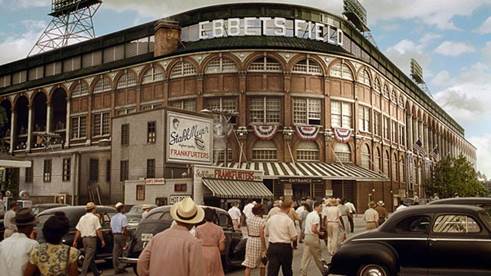
Today, there are 30 teams playing in 30 stadiums in 27 cities (NY, LA and Chicago each have two teams). Of the 24 stadiums opened in the last 30 years, Kansas City-based Populous (f/k/a HOK Sport) has designed 18 of them, including all four we saw on our tour last week. Our first three stops were in cities where the teams have played for more than a century. The fourth, Atlanta, is more complicated. At all stops, we stayed in hotels within easy walking distance of the stadiums – a real treat to avoid traffic.
Pittsburgh – The Old Stadiums: In the Pirates first year at Forbes Field, they won the 1909 World Series. Their star was the great shortstop Honus Wagner, the player on today’s most valuable baseball card ($3.12 million in a 2016 auction). They won the Series again in 1925 and then in 1960 produced one of the most dramatic Series victories when Bill Mazeroski hit a walk-off homer over the left field wall at Forbes.
Forbes Field was also the home of a good Babe Ruth story. Ruth had left the Yankees after the 1934 season and played 28 games for the Boston Braves in 1935. He hit six homers while playing for Boston, the last three in one game at Forbes Field on May 25, 1935 – his 712th, 713th and 714th career homers. His last one cleared the right field roof, the first time any player had done that at Forbes. Ruth retired later that month, but what a way to go out.
Forbes was also the long-time home of the famed Homestead Grays of the Negro Leagues. On July 18, 1930, using a portable lighting system, the Grays played the Kansas City Monarchs in the first-ever night game at Forbes. It would be ten more years before the Pirates would play under lights at the stadium.
In 1970, the Pirates and the NFL Steelers moved to the new Three Rivers Stadium (a/k/a “The House that Clemente Built”). It was located where the Monongahela and Allegheny Rivers join to form the Ohio River. Led by Roberto Clemente, the Pirates won the 1971 Series. On the last day of the 1972 season, Clemente got his 3000th hit. Three months later, he tragically died in a plane crash while on a mission of mercy. In 1979, the “We Are Family” Pirates won the Series. They have not been back since.
Pittsburgh Now – PNC Park: In 2001, Pittsburgh moved into its new baseball-only stadium on the Allegheny just upstream from Three Rivers Stadium. There was buzz to have it named for Roberto Clemente, but PNC Bank is paying $2 million a year for the naming rights. The city did the next best thing – the bridge over the Allegheny was renamed for Clemente and is the centerpiece of the downtown view from the park. [Naming Rights Trivia: We saw four stadiums on the trip, two named for banks and two for insurance companies.] There are three statues outside the stadium: Clemente near the foot of the bridge, Willie Stargell at the left field gate (his position) and Honus Wagner at the main entrance.
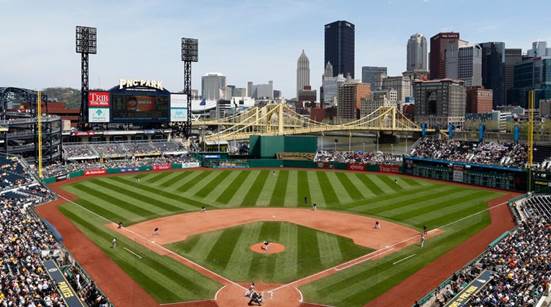
The light standards are replicas of those from Forbes Field, and they are spaced and directed so none block the center field view of the city. To further emphasize the retro style, the field is asymmetrical and has three fence heights: six feet in left, 10 feet in center and 21 feet in right. Why 21? That was Roberto Clemente’s uniform number and he graced right field for the Pirates, winning 12 gold gloves.
There are signs around the stadium bragging that PNC is the best park in baseball. That may well be true. Rita and I have seen 19 of the 30 current stadiums. Two are in a separate category for nostalgia, but not fan comfort – Fenway and Wrigley. Of the rest, PNC and AT&T in San Francisco are likely the top two we have seen. Both are aided by great views (the bay at AT&T), and each is attentive to fan comforts and franchise history (statues, banners, etc.). Kauffman Stadium is nice, but the I-70 view does not resonate in the same way.
We arrived in Pittsburgh a day before our bus tour, so we got in two games at PNC. Prior to the Monday game, we took a guided tour of the stadium that ended with us in field level seats to watch batting practice. The Brewers were in town and this meant we would be seeing former Royal Lorenzo Cain. So of course Rita got his attention and his autograph. But Cain went 0-4 that night and the Brewers lost to the Pirates 1-0.
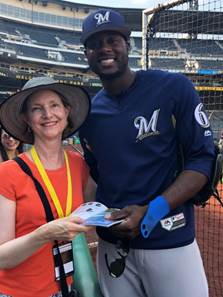
On Tuesday night, Cain did much better as his two infield hits were followed by a homer and a double. There was no question in our mind that he would score from first on the double – “That’s what speed do,” in the immortal words of Jarrod Dyson. The Brewers won 3-2, holding on to first place in their battle with the Cubs and Cardinals for the division lead.
Roberto Clemente Museum: We also visited the Roberto Clemente Museum, a private “by appointment only” attraction, but well worth seeing. There is a ton of memorabilia, and our guide was excellent leading us through Roberto’s personal and professional history. Rita and I are shown below sitting on an old dugout bench from Three Rivers Stadium, beneath the iconic photo of Clemente with angel wing clouds.
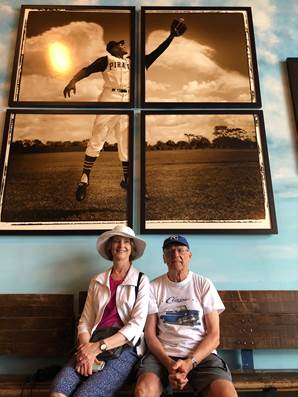
Cleveland – The Old Stadium: In 1932, the Indians moved into the new 78,811-seat Municipal Stadium (a/k/a Cleveland or Lakefront Stadium). The big size did not match attendance, so some games and most of some seasons were played at their prior stadium. When Bill Veeck bought the team in 1946, he moved all games back to Municipal. This proved to be a shrewd move when the 1948 Indians broke the MLB season attendance record and went on to win the World Series over the Boston Braves. My favorite stat from the 1948 pennant race: In his first three starts at Municipal, Satchel Paige drew 202,000 fans. The Indians returned to the Series in 1954, but lost to the Giants and “The Catch” by Willie Mays.
Cleveland Now – Progressive Field: In 1994, the Indians opened Jacobs Field (“The Jake”), named for the brothers who then owned the team. An indicator of the quality of the stadium (and the fans) is that the Tribe had 455 straight sellouts from 1995 to 2001. The naming rights were bought in 2008 by Progressive Corporation, but “The Jake” is still often used by the locals. The entry plaza has statues of Lou Boudreau, Bob Feller and Larry Doby. Across the street is Quicken Loans Arena, home of LeBron James (for now) and the Cavaliers.
Since the Indians move to Jacobs Field/Progressive, they have gone to the World Series in 1995, 1997 and 2016. All losses. They have the longest MLB drought for winning the World Series – going back to that 1948 season at Municipal. 70 years and counting.
After our overnight stay on Pittsburgh, we took a 3-hour bus ride directly to Progressive Field where the Indians were playing an afternoon game against the White Sox. The Indians lead the AL Central, while the White Sox are fighting the Royals for the division basement. Through the kindness of a good guy from Kansas City with ties to the Indians, we sat for a few innings in front row seats behind the Cleveland dugout.
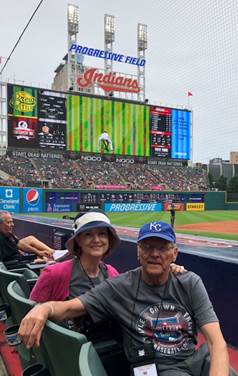
The game was a rout with Cleveland winning 12-0 behind the pitching of Corey Kluber. The happy Indians fans left the stadium to the sounds of “Cleveland Rocks” – just like they did in the intro of the Drew Carey TV show (note in this clip that it was still Jacobs Field when Drew was on the air).
After the game, we checked into our hotel (the Hyatt Arcade which has a cameo in the Drew Carey clip) and then headed over to the Rock and Roll Hall of Fame (also in the Drew Carey clip). Rita and I had been there several years ago, but still had a lot to see. Since we has just seen Bruce Springsteen on Broadway, we took some extra time at his exhibit. It includes his Presidential Medal of Freedom bestowed upon him by President Obama. The Obama quote at the ceremony: “I am the President, but he is the Boss.”
Cincinnati – The Old Stadiums: The Reds played at Crosley Field from 1912 to 1970. During this period they won two World Series, beating the White (Black) Sox in 1919 and the Tigers in 1940. The biggest individual achievement came 80 years ago this month. On June 11, 1938, the Reds Johnny Vander Meer no-hit the Boston Bees at Crosley Field (the Braves went by that name from 1936 to 1941; Casey Stengel was the Bees manager). Four days later, in the first-ever night game at Ebbets Field, Vander Meer no-hit the Dodgers. The only back-to-back no-hitters by a pitcher in MLB history.
The first major league night game was played at Crosley on August 24, 1935. By 1941, nine other teams had added lights. Phil Wrigley, owner of the Cubs, planned to install lights at Wrigley Field for the 1942 season and purchased copper cable and tons of steel for the project. But after Pearl Harbor, Wrigley contributed the materials to the war effort. This delayed light installation at Wrigley until 1988.
The Reds moved to Riverfront Stadium (later called Cinergy Field) on June 30, 1970. The big years in this stadium were 1975 and 1976 when the “Big Red Machine” won back-to-back World Series. Manager Lou Piniella led the Reds to another Series win in 1990. They are still waiting for their next trip.
Cincinnati Now – Great American Ball Park: If it’s Thursday, it must be Cincinnati. Our drive from Cleveland took us straight to Great American Ball Park for a tour of the Cincinnati Reds Hall of Fame and Museum. This is the largest team hall of fame and it is quite impressive. Cincinnati is the oldest professional franchise, dating from 1869, and this place has memorabilia from all decades. My favorite exhibit is a group of life-size statues of the “Great 8” position players from the Big Red Machine of the 1970’s. Almost every Cincinnati fan can rattle off the list (Bench, Perez, Morgan, Concepcion, Rose, Foster, Geronimo and Griffey).
Great American Ball Park opened in 2003. The most fun at the park comes from two steamboat smokestacks in center field that shoot flames when a Reds pitcher gets a strikeout and launch fireworks for homers by the Reds. There is also a nice plaza entry with landscaping and statues of former Reds greats. One shows Pete Rose in his signature head-first slide.
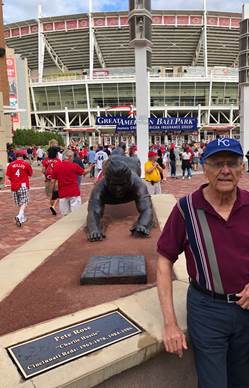
We saw the Reds play the Cubs and an old frenemy was pitching for the Reds – Matt Harvey who moved from the Mets to the Reds this year. As Royals fans no doubt recall, Harvey famously talked the Mets manager into letting him pitch the 9th inning in Game 5 of the 2015 World Series. Bad idea. The Royals tied the game on the Hosmer slide and then won in extra innings to take the Series. We watched as Harvey had a shaky start, but he went on to a 6-2 win with the help of a grand slam by Jesse Winker.
Until a week ago, the Reds had been battling the Royals and the Orioles for the worst record in the majors. But Cincinnati has been on a winning streak, including sweeping the Cubs, and now the Royals and Orioles are alone at the bottom.
Louisville Slugger Museum and Factory: We left Cincinnati on Friday morning and made a stop in nearby Louisville. In 1884, the city was home to the major league Louisville Eclipse whose top hitter was Pete Browning. As the legend goes, 17-year-old Bud Hillerich made a custom bat for Browning in the Hillerich family woodworking shop. Browning got three hits the next day. Word got out and orders started coming in. The custom bats took on the nickname of Pete Browning – Louisville Slugger.
In 1905, megastar Honus Wagner gave the Hillerich bats the first known player endorsement for an athletic product. In 1911, super-salesman Frank Bradsby joined the company and later was made a partner of what became Hillerich and Bradsby. The company continues to manufacture bats to this day, but now under contract to Wilson and Company which bought the Louisville Slugger brand in 2015.
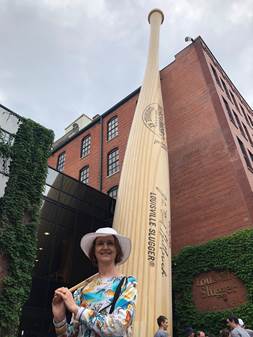
The museum includes bats and endorsements of baseball greats from Cobb to Ruth to DiMaggio to Musial. Ted Williams visited the factory several times to select the wood for his bats, which would then be finished by a lathe operator to Ted’s precise specifications. As we saw in our tour of the factory, the individual manual lathe operation has been replaced by a computer that stores the specs for each player and signals a robotic lathe that completes a bat every 30 seconds.
Nashville: Our bus proceeded to Nashville where we stayed overnight. We had the option of going to the Nashville Sounds minor league game, but Rita and I headed for Lower Broadway to people watch on what is called the Honky Tonk Highway. It was like Mardi Gras except it goes seven days a week all year. Over several blocks, there is live music from almost every bar, often with the stage at an open window next to the sidewalk. We were there in the early evening, but it was already packed. The street was full of party buses, many being bachelorette parties. Rita noted that the primary dress style for the women was jean short shorts and cowboy (cowgirl?) boots.
We then walked a few blocks to Printers Alley where there is another grouping of bars and restaurants. We had been in that area seven years ago with our great friends Larry and Diana Brewer as part of a Nashville-Memphis-Little Rock road trip. Rita was intent on returning to Nashville’s “#1karaoke bar,” Lonnie’s Western Room – not to sing, but to buy another eponymous tee shirt for me. And she did.
Atlanta – The Old Stadiums: The Braves did not relocate to Atlanta from Milwaukee until 1966, but they have already played in three new stadiums. The first was Atlanta-Fulton County Stadium, completed in 1965, but not occupied by the Braves until the next year because litigation delayed relocation. The Braves played in the stadium until 1997, and it was the site of Atlanta’s only World Series win – 1995. The franchise also won a World Series in Boston (1914) and Milwaukee (1957).
A new Atlanta stadium came on board in 1996 to first be used for the Olympics and then converted in 1997 to Turner Field for occupancy by the Braves and NFL Falcons. “Turner” was of course Ted, the Braves team owner and cable entrepreneur. When Turner opened in 1997, Bartolo Colon was a rookie pitcher for the Indians. Turner Field was demolished after the 2016 season. Bartolo Colon is still pitching in the majors (21st season). He personally outlasted Turner Field.
Atlanta Now – SunTrust Park: This was our final stop on the trip. SunTrust Park opened in 2017 and so it is the newest in the majors. It’s a nice stadium, but we were most impressed by “The Battery,” a retail, dining, apartment and hotel development that has built up around SunTrust Park. We stayed in one of the hotels and walked over to our 4:10 game between Atlanta and Baltimore. The Battery was jammed with people both before and after the game. To get a feel for the vibe, imagine Kauffman Stadium relocated between the Power and Light District and the Crossroads.
Rather than a separate building for a Hall of Fame, the Braves have a walk-through Monument Garden that features players and highlights from franchise history. The center-point is a statue of Hank Aaron in front of a display of 755 Louisville Slugger bats to match his career number of homers.
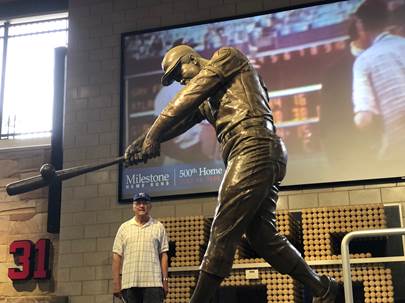
In the first inning of the game, the Orioles put their first three men on base and Mark Trumbo then hit a grand slam to lead Baltimore to a 7-5 victory. This win by the O’s kept them slightly ahead in the race with the Royals for the MLB cellar.
Hank Aaron Weekend: Our Saturday game was part of Hank Aaron Weekend. Aaron spans all three cities of the Braves franchise. He signed with the Boston Braves in 1952 and was in their minor league system when the Braves moved to Milwaukee in 1953. Aaron joined Milwaukee in 1954, and after 12 seasons there, moved with the team to Atlanta in 1967 for another 9 seasons.
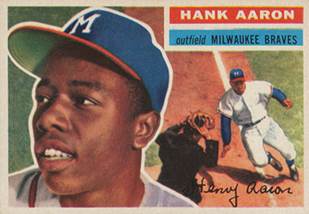
We had already been to a city (Cincinnati) that was home to a couple of key moments from Hank’s history – he got his 3,000th hit at Crosley Field in 1970, and he hit home run #714 in 1974 at Riverfront Stadium. It occurred to me while typing this that the first two players to hit their 714th home run were playing for the same franchise – Ruth for the Braves of Boston and Aaron for the Braves of Atlanta. Aaron broke Ruth’s record when he hit #715 on April 8, 1974, in Atlanta-Fulton County Stadium. [Career Homer Trivia: The top four career home run hitters are Barry Bonds (762), Hank Aaron (755), Babe Ruth (714) and Alex Rodriguez (696). Two may never make it to the Hall of Fame.]
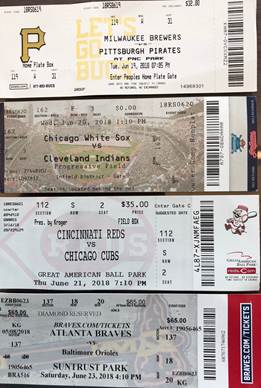
Anniversary Card: I can’t resist sharing a 37th anniversary card that was sent to me and Rita. Bill Wakefield played for the Mets in 1964, and his manager was Casey Stengel. Casey’s uniform number for the Mets (and for his days with the Yankees) was 37. Click here to see Bill’s card to us. [Wakefield Trivia: In July of 1960, the 19-year old Wakefield pitched two consecutive no-hitters for Katz in KC’s Ban Johnson League. Our own Johnny Vander Meer.]
Lonnie’s Jukebox – “We Are Family”: This could also be titled Willie’s Jukebox because it was Willie Stargell who urged the 1979 Pirates to adopt “We Are Family” as the team anthem. Willie was 39-yrs-old and fondly referred to as “Pops” by the younger players. The team was struggling early in the season, and after a come-from-behind victory on June 1, Stargell sang “We Are Family” in the clubhouse. The song stuck with the players and fans. “The Family” was stenciled onto the dugout and the theme was on shirts and signs. The song blared out at the stadium. It helped that the team kept winning.
Willie also awarded “Stargell Stars” to fellow players for big plays and had the equipment manager sew them on the cool pillbox hats from the era. In this photo, it looks like someone also awarded stars to Willie for his heroics:
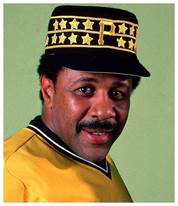
“We Are Family” was by Sister Sledge, four disco-singing sisters who released the song on an album in January of 1979, followed by the single in April. The record started with moderate success, but then jumped up the charts as the Pirates dazzled the baseball nation with come-from-behind victories and the image of a winning family of ballplayers. Both the album and the record hit one million in sales by the end of the year. A bittersweet result for the Philadelphia sisters who were Phillies fans.
Willie likewise ended with a good year, leading the Pirates to a World Series win over the Orioles. He was the MVP of the NL (shared with Keith Hernandez), as well as MVP of both the NLCS and World Series. He shared the “Sportsmen of the Year” award from Sports Illustrated with the Steelers’ Terry Bradshaw who also played in Three Rivers Stadium.
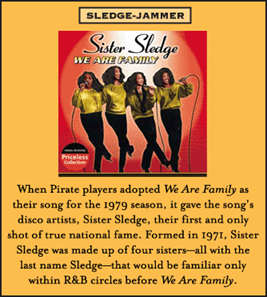
Click here and feel free to dance like no one is looking.
Bonus Cut: My thanks to Richard Martin for the heads-up on this. If you have not seen Paul McCartney’s recent appearance on James Corden’s “Carpool Karaoke” – and have 23 minutes – this clip is priceless.